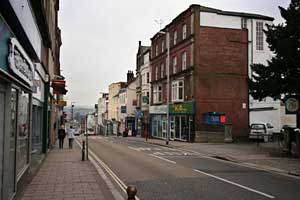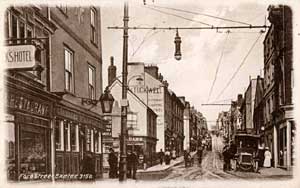
Fore Street
Page updated 26 July 2009
Streets List Fore Street Photographs - Then and Now
 A common name in Devon,
it means the street that is below or continues
on from the High Street. The position of Fore Street in Exeter may be
due to King
Alfred's period of town planning,
along with Gandy Street. Before about 1739 Fore Street
stretched as far as St Stephen's Church in the High Street, causing
considerable problems for the unwary historian.
Before the continuation of Fore Street down
New Bridge Street to meet the new Georgian Exe Bridge of 1788, Fore
Street was not nearly so prominent as a through road.
The main route into Exeter from the medieval Exe Bridge was originally
up Stepcote Hill and Smythen Street to meet the High Street a little
east of Broadgate. Although the
majority of the buildings in the street date from the 18th and
19th-century, St
Olaves Church and Tuckers
Hall date back to mediaeval
times.
A common name in Devon,
it means the street that is below or continues
on from the High Street. The position of Fore Street in Exeter may be
due to King
Alfred's period of town planning,
along with Gandy Street. Before about 1739 Fore Street
stretched as far as St Stephen's Church in the High Street, causing
considerable problems for the unwary historian.
Before the continuation of Fore Street down
New Bridge Street to meet the new Georgian Exe Bridge of 1788, Fore
Street was not nearly so prominent as a through road.
The main route into Exeter from the medieval Exe Bridge was originally
up Stepcote Hill and Smythen Street to meet the High Street a little
east of Broadgate. Although the
majority of the buildings in the street date from the 18th and
19th-century, St
Olaves Church and Tuckers
Hall date back to mediaeval
times.
Railway time?
St John's Church on the lower corner of John Street was finally demolished in 1935 and hence was lost the prominent illuminated clock that hung from its fabric. When you looked for the time in Fore Street the extra minute hand on the 'the moon of Fore Street', as it was known, would give you the choice of railway time or Exeter time. The opposite corner of John Street was the site of the Star Inn known from before 1680 and a handy meeting place for the Worshipful Company of Weavers, Fullers and Shearmen of Exeter when they met away from Tuckers Hall. The inn was also one of several meeting places for the Masonic Lodge, St. John, No. 70, in Exeter.
Thomas Moore, is the oldest still surviving business, and will be celebrating its centenary in 2007; the name of its founder can be found on the memorial to the fallen of the First World out side St Olave's Church. The present Walkabout Bar was the Franklin Picture Palace between 1911 and 1924, and one of the venues where the local character Artful Thomas could be found.
Although bounding the area commonly known as the Westquarter, the citizens of Fore Street escaped lightly the outbreak of cholera that hit Exeter in 1832. Only three died of the disease between July and October, despite the frequent tolling of the St Olaves bell for the many funerals in the area. In the parallel Smythen Street and Stepcote Hill, and all the courts and places running off them, matters were very different, with 24 and 15 deaths respectively, just 50 metres away.
A campaigning newspaper
Fore Street was the centre of the newspaper and printing trade in Exeter during the 19th and 20th-century. No 143, Fore Street, the 18th-century town house of Sir Thomas Bury, was the headquarters of the Western Times, run by Charles Dicken's friend, Thomas Latimer. It was Latimer who introduced Exeter's first steam driven printing press, increasing the 300 copies per hour output from the manual press to 1,400 from steam.
In 1848, Bishop Phillpotts took Latimer to court for defamation, after an article accused the Bishop of lying about the dismissal of the Reverend James Shore, from his living near Totnes. Many predicted a year of hard labour for the reforming editor but he was acquitted of the charge and welcomed back to the office of the Western Times in Fore Street by a cheering crowd of several thousand. When the newspaper moved to the High Street, Wheaton's established a shop and then a printing works at the address - their printing factory stretched back to Bartholomew Street.
Fore Street was also a popular venue for the drinker with many forgotten public houses, and even hotels. Now all that is left are the Velvet Lounge, formerly the Devonport Arms, The Mint and the Hogs Head. For a map showing at least eight public houses in Fore Street see West Quarter pubs.
The top of Fore Street was largely destroyed in the bombing of 1942, and Fowler's Lower Market and the Chevalier Inn were both lost to fire and explosion. However, for those who care to look, Fore Street has some interesting and historic architectural gems along its length, and a range of interesting, eccentric and colourful shops that are anything but the clones you find elsewhere in Exeter.
Peter Hinchliffe remembered Otton's the ironmongers in Fore Street "In the latter years the company was run by Reg Otton a bachelor who lived in that nice Georgian house called Walnut house, in St Davids Hill. He had one or two notable assistants Jimmy Baskerville for one – when he died in the late 60s/70s Reg Otton left all the very senior men £100 each and he left the business to the staff, who sold the premises and moved down to Marsh Barton before selling to Jewson."
The following paragraphs are from People Talking
All sorts of shops
Fore Street had the West Quarter in behind. There were endless shops on Fore Street: there was Patch, the butcher; Cornish, the butcher; Rice's, the fish shop, Troke's, the poulterer where you'd buy rabbit and all that sort of thing cheap. Next door, to that was a greengrocer's called Passmores. There used to be a Dairy shop called Gills where people used to buy their skimmed milk with a jug. On the opposite side, the Matthew the Miller side, was a well known pub and beside that a barber shop.
Cheese
There was a man used to sell cheese, Pilley and he had his cheeses all lined up in the doorway; the dogs used to nurture them with care. The children used to sing, "I've seen spiders in Pilley's cheese". They sold salt fish as well. Salt fish was very popular; you soaked it overnight and then fried it.
Free hats
There was Pinnegar's, the drapers next to the Mint Chapel, a very big drapers. Occasionally, they put a large cardboard box of hats outside on the pavement with a big notice, saying, "Please take one". After that Ackroyds joined them and it became Pinnegar and Ackroyd's.
Everything delivered
A boy who could be kept at school till he was 14 was very fortunate. If he left school at 12, probably he had to get himself a job somewhere. There were all sorts of trades but errand boy was a favourite one. A lot of errand boys worked for the traders on Fore Street. There were so many shopkeepers who could afford to have a boy to run fetch and carry for virtually nothing. Everything was delivered then.
I remember the bicycles with a big basket in the front and sometimes one at the back as well. Then they had an advertisement through the middle.
World War One Dead - Fore Street
Private, Bert Green, Dorsetshire Regiment. 23
November 1918. Age 21. Fore St
Private, Claude Challice, Devonshire
Regiment. 25 September 1915. Age 31. Fore St
Private, Walter John
Green, Gloucestershire Regiment. 3 November 1917. Age 25. Fore St
Private,
S Clatworthy, Devonshire Regiment. 26 October 1917. Age 26. Fore St
Source: Flying Post, Cobbet of the West and People Talking
 Looking down a modern Fore Street.
Looking down a modern Fore Street. An Edwardian
Fore Street from New Bridge Street.
An Edwardian
Fore Street from New Bridge Street.  St
John's Church 'Moon of Fore Street' clock is on the right.
St
John's Church 'Moon of Fore Street' clock is on the right.  A
traffic accident on 25 April 1906 in Fore Street.
A
traffic accident on 25 April 1906 in Fore Street.  The
Devonport Inn (Vivo) is second from the left.
The
Devonport Inn (Vivo) is second from the left.
│ Top of Page │